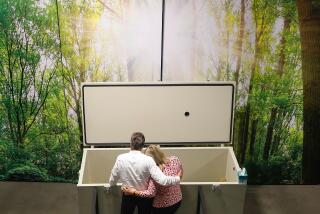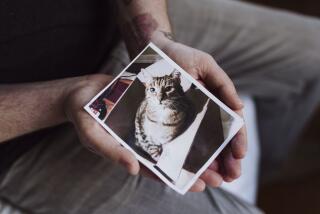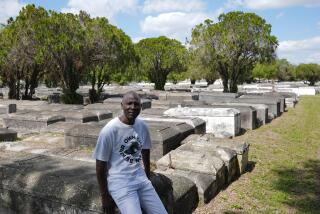He’s Keeping the Family Name Alive
- Share via
Roy Brown is a holdout.
Forty-two years after his graduation from mortuary school, Brown is still running the family business in an industry dominated by corporate buyouts, partnerships with memorial parks and direct-to-buyer casket companies.
The 66-year-old Lake Forest resident is uncertain what the future holds for Brown Colonial Mortuary, founded 70 years ago this September in Santa Ana by his late father. But the legacy continues. His 30-year-old son, Gerran, joined the business two years ago.
“We are now seeing major corporations buying up mortuaries right and left,” said Brown, who estimates there are fewer than a dozen independently owned mortuaries left in Orange County. “The rest are all corporate mortuaries. They still might have the old names, but they’re corporate owned.
“One of the best funeral directors I’ve ever known sold his firm to a big corporation, and his statement was: ‘My son isn’t interested in the business, so why should I fight it?’ ”
Brown was 15 years old when he decided to follow in his father’s footsteps. The decision was thrust upon him by the death of his father.
“I always had the feeling that my dad didn’t really want me to go into the business, but he died when I was a sophomore in high school,” Brown said. “My mother said, ‘Roy, we’ve just got to get you into the business.’ I had grown up around the mortuary, so it was not something I was really fearful of. It never bothered me a bit.”
His father, Harold R. Brown, was a Santa Ana High School graduate whose experience as a World War I ambulance driver led to an ambulance-driving job at a San Francisco funeral home. Harold Brown spent eight years learning the business, then returned to Santa Ana to start the mortuary in 1927.
Roy Brown’s first job in the family business came at age 7 during an open house for the mortuary’s new location. It was moved in 1937 to a newly constructed building across the street from the old house where the business began.
“I was the door man. I remember it well; it was a hot day.”
After 60 years at the same location, Brown said the mortuary feels a lot like home.
“I’d walk through the place as a kid when we lived close by. And the same thing was true for my children; they would walk through as we were dressing bodies, or we’d have them help us and take a casket and put it in a room somewhere. Pretty soon, you don’t think much about it, as long as it’s someone you don’t know.”
One of the biggest changes over the years has been in the way services are conducted, Brown said.
“One of the things that got the funeral industry in trouble was that we were not flexible. The funeral services were all pretty much the same--the pallbearers, the black family car, the organist and soloist--and people were starting to say, ‘Funerals leave me cold. There’s just nothing there.’
“So now you talk to people and see where they’re coming from. If they’re very traditional, then it’s kind of easy.
“One thing I’ve learned is to try and get participation in the service. Let someone in the family or a friend say something; let friends carry the casket if at all possible. It’s good to work people in and it leaves a warm feeling with the survivors. If they don’t come out of the ceremony with some feeling of relief, we’re not doing our job.”
There have also been changes in the way morticians handle and store bodies, Brown said.
A change in state law about 25 years ago ended mandatory embalming, which preserves a body for about two weeks, and brought in the era of refrigerated storage. And morticians now treat each body as capable of transmitting the AIDS virus, “whether it be a 90-year-old nun, or a young guy who looks like he might be a drug addict.
“Consequently, they go in there to prepare the body looking like they’re going to the moon. They’ve got shoe covers on, disposable plastic coveralls, a face mask and headpiece, and some use breathing devices. The fear is there.”
*
There is also more competition in the funeral industry than ever before, Brown said, especially with the advent of independently run casket stores.
“Traditionally in the funeral business, the casket carried a pretty good chunk of the overhead,” he said. “If this continues, funeral homes are going to have to change their pricing.”
But he does not encourage his customers to buy overly expensive models.
“A casket is about 90% mental perception and about 10% substance, because we’re all going to return to the dust someday anyway. We’re not going to prevent it. I always say, ‘If you want to pay for it, we’ll get something nice.’
“We’ve got caskets with 75-year guarantees. People laugh at it and I laugh right along with them. Who’s going to check?
“A funeral service or a memorial service is the final life celebration--it’s really for the living. How the body is disposed of is not as important as putting together something that’s meaningful for the people involved.”
(BEGIN TEXT OF INFOBOX / INFOGRAPHIC)
Profile: Roy Brown
Age: 66
Hometown: Santa Ana
Residence: Lake Forest
Family: Wife, Joyce; four adult sons
Education: Bachelor’s degree in industrial relations, Loyola University; professional training with the California College of Mortuary Science
Background: Two years as an aircraft controller in the Air Force; joined his late father’s business, Brown Colonial Mortuary in Santa Ana, in 1954
On the family business: “If you grow up around this business, it’s not something you’re fearful of. My boys grew up around here. We used to have a refrigerator in the garage and I would fill it with soft drinks. We’d come home from school and they’d all come into the mortuary to have their soda pop and off they’d go again and never think a thing about it.”
Source: Roy Brown; Researched by RUSS LOAR / For The Times
Los Angeles Times
More to Read
Inside the business of entertainment
The Wide Shot brings you news, analysis and insights on everything from streaming wars to production — and what it all means for the future.
You may occasionally receive promotional content from the Los Angeles Times.










